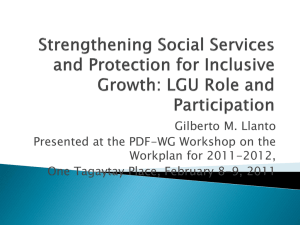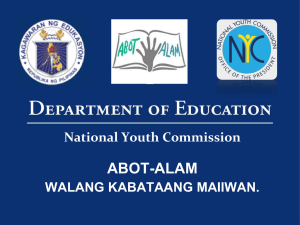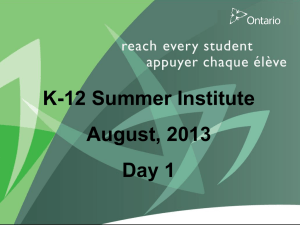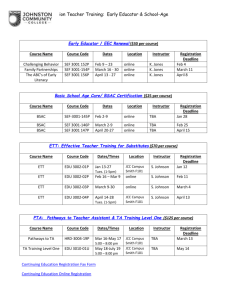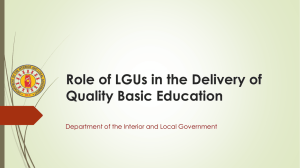Project Proposal - deped-ops
advertisement
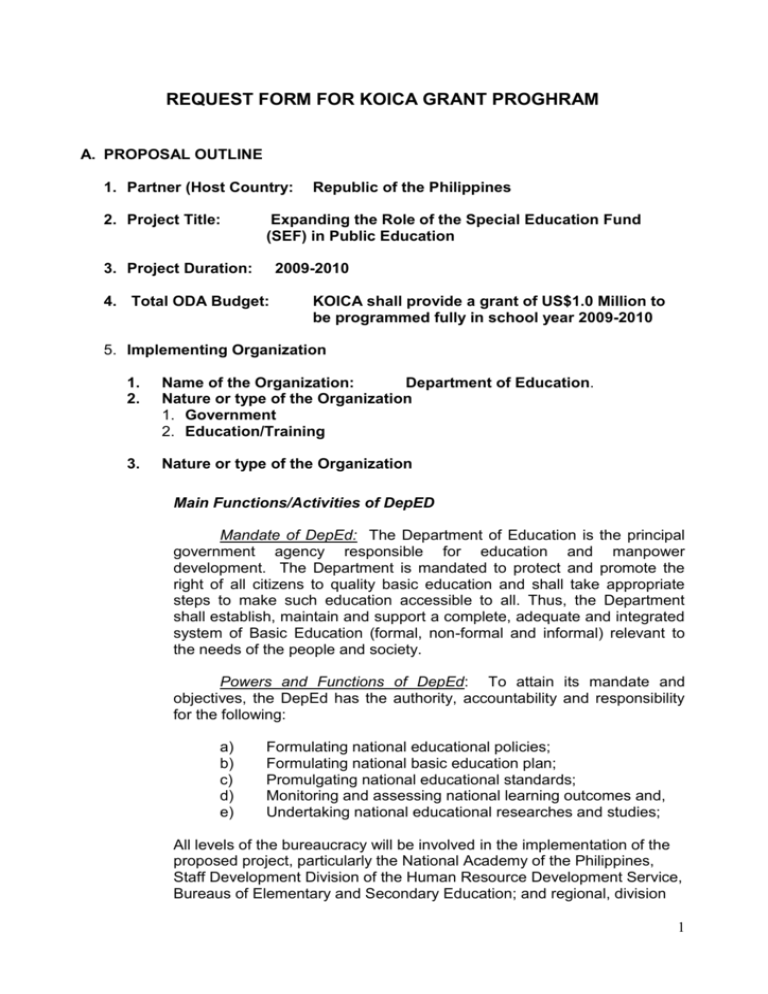
REQUEST FORM FOR KOICA GRANT PROGHRAM A. PROPOSAL OUTLINE 1. Partner (Host Country: 2. Project Title: Republic of the Philippines Expanding the Role of the Special Education Fund (SEF) in Public Education 3. Project Duration: 2009-2010 4. Total ODA Budget: KOICA shall provide a grant of US$1.0 Million to be programmed fully in school year 2009-2010 5. Implementing Organization 1. 2. Name of the Organization: Department of Education. Nature or type of the Organization 1. Government 2. Education/Training 3. Nature or type of the Organization Main Functions/Activities of DepED Mandate of DepEd: The Department of Education is the principal government agency responsible for education and manpower development. The Department is mandated to protect and promote the right of all citizens to quality basic education and shall take appropriate steps to make such education accessible to all. Thus, the Department shall establish, maintain and support a complete, adequate and integrated system of Basic Education (formal, non-formal and informal) relevant to the needs of the people and society. Powers and Functions of DepEd: To attain its mandate and objectives, the DepEd has the authority, accountability and responsibility for the following: a) b) c) d) e) Formulating national educational policies; Formulating national basic education plan; Promulgating national educational standards; Monitoring and assessing national learning outcomes and, Undertaking national educational researches and studies; All levels of the bureaucracy will be involved in the implementation of the proposed project, particularly the National Academy of the Philippines, Staff Development Division of the Human Resource Development Service, Bureaus of Elementary and Secondary Education; and regional, division 1 and district offices and schools in the project areas. The overall functions of these units are as follows: National Educators Academy of the Philippines (NEAP) a) b) c) d) Provides continuing strategic human resource development programs for school managers and leaders within the context of emerging legitimate demands on scarce human and material resources; Promotes synergetic partnerships and linkages with centers of excellence locally and internationally, from both government and non-government sectors; Develops programs that address career planning and pathing for potential educational managers and leaders, and Promotes intellectual inquiry into non-traditional and innovative alternatives and strategies in educational management Human Resource Development Service a) b) c) Develops and administers a personnel program which includes selection and placement; classification and pay, career and employment development, performance rating, employee relations and welfare services Acts on matters concerning attendance, leaves of absence, appointments promotions and other personnel transactions; Conducts training programs in the DECS. Bureaus of Elementary and Secondary Education a) b) c) Conduct studies and formulates, develop and evaluate programs and educational standards for elementary/secondary education Undertake studies necessary for the preparation of prototype curricular designs, instructional materials and teacher training programs for elementary/secondary education Formulate guidelines to improve elementary/secondary schools physical plans and equipment, and general management. Regional Offices a) b) c) d) Define regional educational policy framework which reflects the values, needs and expectations of the communities they serve; Develop regional basic education plan; Develop regional educational standards with a view towards benchmarking for international competitiveness; Monitor, evaluate and assess regional learning outcomes; 2 e) f) Undertake research projects and develop and manage regionwide projects which may be funded through official development assistance and/or funding agencies; Formulate in coordination with the Regional Development Council, the budget, utilization of resources, based on identified priorities in the implementation of regional development plan; Division Offices. a) b) c) d) Develop and implement division education development plans; Plan and manage the effective and efficient performance of all personnel, physical and fiscal resources of the division, including professional and staff development; Promote awareness of and adherence by all schools and learning centers to accreditation standards prescribed by the Secretary of Education; and Supervise the operations of all public and private elementary, secondary and integrated schools, and learning centers District Offices. a) Provide professional and instructional advice and support to the school heads and teachers of schools and learning centers in the district or cluster; b) Provide curricula supervision; and c) Perform other functions as may be assigned by the Secretary, Regional Directors and Schools Division Superintendent School a) b) c) d) e) f) g) h) i) j) Set the mission, vision, goals and objectives of the school; Create an environment within the school that is conducive to teaching and learning; Implement, monitor and assess the school curriculum; Develop the school education program and school improvement plan; Offer educational programs, projects and services which provide equitable opportunities for all learners in the community; Introduce new and innovative modes of instruction to achieve higher learning outcomes; Administer and manage all personnel, physical and fiscal resources; Provide opportunities for staff development; Establish school community network; and Accepts donations, gifts, bequest and grants in accordance with existing laws and policy of the department for the purpose of upgrading teachers competencies 3 d. Manager of this Project: 1. Name and Position: Psyche Vetta G. Olayvar Deputy Executive Director, EDPITAF 2. Phone/fax Number/Email Address: 633-7256/cheolayvar@yahoo.com 6. Sector of the Project: Education B. PROJECT DESCRIPTION 1. Historical Background of the Project: Present conditions in the sector: In a slow-growing economy with limited budgetary resources, how does a country such as the Philippines keep pace with the growing demand for quality education? In recent years, expanding the national budget for public education has barely kept pace with population leaving the sector with real negative growth over the past half-decade. While the Department of Education receives the single largest budgetary share of any government department or sector as mandated by the Constitution, the country’s investment in education as a share of GNP remains far behind its closest neighbors in Southeast Asia. Worse is, almost 90% of which goes to personal services. This relatively low investment in education spending is reflected in the poor education performance in terms of Education for All indicators and international tests in science and mathematics. Does National Government, however, have to be the sole provider and financier for public education? In truth, how can National Government finance and support an increasingly overburdened education infrastructure? One source of funding available to public education is the Special Education Fund (SEF) provided under the Local Government Code. Based on local real estate assessment, the SEF provides each local government unit (LGU) with a source of funding for local education. But are LGUs maximizing the collection of SEF as provided under existing law? And are local school boards (LSBs) wisely and efficiently utilizing the SEF in ways that enhance the delivery of public education in their localities? Special Education Funs (SEF)1 a. The Special Education Fund (SEF) is a special tax on local real estate provided under the Local Government Code. The law provides that landowners be assessed one percent (1%) of the value of real properties (i.e. land, buildings, machinery and improvements) to be set aside to fund 1 Much of the data and information provided by a study on the Special Education Fund undertaken by the Public Finance Institute of the Philippines in 2002 under a grant provided by the Ford Foundation. 4 local education and to be administered by local school boards (LSB). b. In 2002, the Bureau of Local Government Finance (BLGF) of the Department of Finance (DOF) reported that _____ LGUs2 collected a total of P9.0 Billion in SEF, of which P7.8 Billion went directly to LSBs.3 c. Against a departmental budget of P110.0 Billion in 2004, the combined LSB portfolio of P7.8 Billion represents an additionality of 7.1% in total spending for general education purposes.4 Because local real estate tax collection has been the fastest growing revenue source for LGUs since 1992 (+22% over the period), the SEF has likewise grown in size (though still largely under-collected.) d. Given the size of LGUs, however, the SEF funds vary from a low of P20,000 per year to as much as P1.0 Billion for the city of Makati, the financial center of the country. The variability of the size of the SEF is a function of the economic wealth and activity of the LGU as well as the tax collection efficiency of the town, city or province. A sample of LGUs done by Synergia Foundation reveal a wide range in tax collection efficiency. LGU Collection Efficiency Polomolok, South Cotabato 90 % Tagbilaran, Bohol 90 % Bayombong, Nueva Vizcaya 70 % Pili, Camarines Sur 50 % Naga City 50 % General Santos City 50 % Angeles City 50 % Sasmuan, Pampanga 19 % e. There are other reasons as well for the variable tax collection efficiency and the varying amounts raised: 2 Real property undervalued.5 taxes, in general, continue to be grossly In this case, LGUs that assess local real estate taxes are limited to provinces, cities and municipalities. 3 The propensity to tax varies from LGU to LGU. In some LGUs, tax rates have been increased as the quickest way to increase local revenues. In other LGUs, tax rates have not been raised in order not to alienate taxpayers. 4 In addition to the SEF, the Department has also been able to raise additional funds for education through the Brigada Eskwela and Adopt-a-School programs. Brigada Eskwela is the one week “National Schools Maintenance Program” that encourages parents, the local business community, LGUs and the community-at-large to come together for one week in May (prior to the opening of the school year) to do minor repairs on school buildings and other facilities. In May 2003, the effort contributed over 892,000 man-days of volunteer time and materials donated to 12,505 schools worth a combined value of P392 Million. In May 2004, over 16,000 schools participated with over 1.4 million volunteer man-days and materials donated worth a total of P717 million. The Adopt-a-School program, on the other hand, involves donated funds or goods and services in-kind from private companies and individuals made available for specific schools or for the department. From October 2002 through August 2004, during the term of then Secretary Edilberto C. de Jesus, some 80 private corporations and corporate foundations made over P350 Million in registered contributions to the Department of Education. 5 The law also provides that certain types of land be taxed differently (i.e. different tax rates). This contributes to the difficulty in real estate assessment and hence, tax collection. 5 Incomplete, inaccurate land records Continuing tax amnesty programs for delinquent taxpayers6 f. To administer the SEF, the LGC provides that local school boards be set up. These LSBs have the following mandated composition: Chair: Local Chief Executive (e.g. governor or mayor) Co-Chair: Schools Division Superintendent Members: Chair, Education Committee, Sangguniang7 LGU Treasurer Representative, Youth sector Representative, PTCA (Parent-Teachers-Community Association) Representative, Teachers’ organizations Representative, Non-Teaching organizations The membership in the LSB, however, can be expanded. In the case of Naga City and Nueva Vizcaya, the membership has been expanded to include representatives from non-governmental or civil society organizations (NGO, CSO) as non-voting members. g. Under the LGC, local school boards have the following authorities and responsibilities: To determine the annual supplementary budgetary needs of public schools within the LGUs;8 To authorize the local treasurer to disburse the SEF; To serve as the advisory committee on education to the Sangguniang; and, Other purposes including the naming and/or renaming of schools in their area. h. The LSBs have exercised their authorities quite liberally in terms of funding priorities. By law, the LGC specifies the proper uses for the SEF and limits this to the following: Construction, repair and maintenance of schools and other facilities Provision or establishment of extension facilities (i.e. non-formal 6 Editorial comment: In general, tax amnesty programs tend to encourage taxpayers to avoid paying the right amounts of tax if they can project an amnesty in the near future. In the city of Paranaque, however, a change in mayor led to a one-time amnesty program at the start of the new mayor’s term. Taxpayers who refused to pay local taxes under the previous mayor, came out in droves to pay arrears under the new mayor. This provided the new administration with a windfall from previously unpaid local taxes which it used to improve on garbage collection and street and sidewalk repairs, among others, making an immediate impact on the city’s residents. 7 The sangguniang is the provincial, city or town council. It serves as the legislative body of the LGU. 8 Supplementary to the funds provided by the National Government under the General Appropriations Act. 6 i In actuality, LSBs spend the funds on a wider range of priorities. general, the funds were divided into the following major categories: j education or alternative learning systems)9 Sports activities In Capital outlay (new construction, office/facilities improvements and office equipment) – 35% Salaries and allowance of teachers (either locally-funded teachers or to provide additional allowances to nationally-funded teachers)10 – 25% Maintenance – 40% But there have been other uses as well. LSBs also spent SEF on the following: Athletic meets (from 10% - 47% in some LGU cases) Cultural events Scouting (i.e. boys and girl scout activities and programs) Others (including the purchase of cell phones) A sampling of LSB priorities are as follows: Bulacan (province) - 43% school building construction and repair Bohol (province) 26% salaries, 20% school building construction and repair Naga City 61% salaries Tagbilaran City 62% salaries, 11% school building repairs General Santos City 83% salaries, 13% sports Nueva Vizcaya (province) -91% salaries Polomolok (town) 65% salaries, 12% school building construction and repairs k. Other more specific, though extremely limited, uses include: Anti-insurgency campaigns (South Cotabato province) Aid to dormitory operations (for students and teachers) (Bohol province) PTCA presidents travel and radio equipment (Talibon, ____) 9 In mid-2004, the Department formally changed the name of the Bureau of Non-Formal Education (BNFE) to the Bureau of Alternative Learning Systems (BALS). 10 Nationally-funded teachers are provided for the Department under the General Appropriations Act (GAA). In many instances, given shortages in teachers, LGUs fund what are classified as “locally-funded teachers”. These teachers are subject to the same screening and hiring policies of the Department but do not have tenure or a regular plantilla position and can be hired and fired by the LGU at any time. In addition, many are paid lower than nationally-funded teachers given the paying capacity of the LGU and the LSB. 7 National/Local government development policy in the sector The Philippine EFA 2015 Plan is a vision and a holistic program of reforms of the country to achieve an improved quality of basic education for every Filipino by 2015. The Plan is anchored on the Dakar Framework of Action adopted by various participating countries including the Philippines during the World Education Forum in April 2000, Dakar, Senegal. The Dakar Framework for Action is a re-affirmation of the vision set out in the World Declaration on Education For All (Jomtien1990) that every child, youth and adult has the human right to benefit from education that will meet their basic learning needs including the full development of human personality The Philippine EFA 2015 Plan adopts the prescription of the World Declaration on Education For All that basic learning needs shall be made available to all by various means- by way of schools or formal education or by way of alternative learning schemes such as informal and non-formal education. Based on this, the central goal of EFA is a basic competency for all that will bring about functional literacy for all with the following component objectives: 1. Universal Coverage of Out-of-School Youth and Adults in the Provision of Basic Learning Needs: All persons beyond school-age who for various reasons have failed to acquire the essential competence to be functionally literate should finally be made functionally literate in their native tongue, in Filipino and in English. Functional literacy is merely the first step for these disadvantaged adults to become educated Filipinos in the sense articulated by EDCOM. Achievement of this outcome requires that the many social, political, cultural and economic mechanisms that are already reaching these persons should be enhanced by adult literacy programs. This outcome involves reaching and educating up to about 9 million functionally illiterates as of year 2003. 2. Universal School Participation and Elimination of Drop-outs and Repetition in First Three Grades: All children aged six should enter school ready to learn and prepared to achieve the required competencies for Grade 1 to 3 instruction. Attainment of this outcome is just the first installment for insuring that education disadvantage does not take root early thereby limiting the future options available to disadvantaged pre-school children. Achievement of this outcome requires that quality-assured programs for pre-school and early childhood care and development should be expanded to reach all children aged 3 to 5 years old, with first priority to reaching first those children least likely to enter school or most likely to drop-out or repeat in Grades 1 to 3. This outcome involves reaching about 5.7 million children aged 3 to 5 years old, with about 20% of these (1.2 million children) comprising those least likely to enter Grade 1 and most likely to repeat or drop out between Grade 1 to 3. 3. Universal Completion of the Full Cycle of Basic Education Schooling with Satisfactory Achievement Levels by All At Every Grade or Year: All children aged six to eleven should be on track to completing elementary schooling with satisfactory achievement levels at every grade, and all children aged twelve to 8 fifteen should be on track to completing secondary schooling with similarly satisfactory achievement levels at every year. Attaining this outcome assures that schooling will become a real factor in eliminating education disadvantage regardless of socio-economic circumstances of school age children. Achievement of this outcome requires that all elementary and high schools work with their respective communities to jointly take full responsibility for assuring that all school-aged children stay in school, that no student is allowed to significantly lag behind in grade level achievements, and that every student attains the required level of competency necessary for the next grade level until graduation. This outcome involves a school-age population of 12.6 million children aged 6 to 11 years old (elementary schooling) and another 7.6 million children aged 12 to 15 years old (high school). This also involves getting every one of the almost 40,000 elementary schools (36,000 public and 4,000 private) and the almost 8,000 high schools (5,000 public and 3,000 private) to perform above a desired minimum level of effectiveness. 4. Total Community Commitment to Attainment of Basic Education Competencies for All: Every community should mobilize all its social, political, cultural and economic resources and capabilities to support the universal attainment of basic education competencies in Filipino and English. Education for all demands nothing less than all for education. Attainment of this outcome assures that education disadvantage is not allowed to grow or remain in any Philippine community. Achievement of this outcome requires a mass movement that reaches and engages every community of the country. Such a movement involves not just government, but also civil society, business, media and all other institutions and organizations important to the civilized functioning of societies. This outcome involves organizing a community-level effort at each of 79 provinces, 114 cities, 1,496 municipalities, and possibly 41,945 barangays. To attain the EFA goals, one of the strategies to be pursued is the strengthening of Muslim Education. The development and adoption of the National Standard Curriculum for Muslim Education to be used by both public schools and Madaris has been considered as a breakthrough in Philippine basic education. Annex X shows DepED Order 51, series of 2004. The issuance is a strategic response to the global commitment of the country to Education for all to provide access to education of whatever delivery system. Its primary purpose is to provide Muslim Filipino quality Islamic Friendly Education based on the existing national curriculum of the Department of Education Basic Education Sector Reform Agenda (BESRA) is a policy reform package of institutional, structural, financial and other critical changes necessary to accelerate, broaden, deepen and sustain education reform. It would be the basis of GOP directions and actions towards attainment of EFA goal which is improved basic education competencies for all Filipinos. BESRA consist of five key reform thrusts: schools, teachers, DepEd organization, complementary interventions, and institutional environment. Each key reform thrust consists of a number of policy actions that would bring about change in the DepED system. The five Key Reform Thrusts are as follows: 9 1. School stakeholders improve their own schools continuously 2. Professional standards for teachers meet demand for better outcomes 3. DepEd central, regional and divisional levels focus on aligning people’s collective aspirations for education with actual teaching practices in schools and learning outcomes attained by Filipinos. 4. Providers of early childhood care and development, alternative learning services, and private sector increase their respective complementary contributions to national basic education outcomes. 5. National government creates the conditions for changing the culture of DepED in support of BESRA. Problems to be solved in the sector 1. The challenge for the Department of Education (and all local government units) is how to channel more funds from the SEF to public education. 1.1 In 2002, the Bureau of Local Government Finance calculated that the total potential for the SEF in aggregate at P14.4 Billion (based on real property assessments nationwide). 1.2 This is in contrast to actual aggregate SEF collections of P9.0 Billion (62.5%)… 1.3 And, actual aggregate SEF spending (as reflected in LSB budgets) at P7.8Billion (54.2% of total potential; 86.7% of actual collections) 2. How can the Department work with LGUs to increase SEF for education? 2.1 2.2 3. How to increase tax collection efficiency? How to increase absolute LSB levels for public education? Can DepED capture more of the SEF in the LSB budgets? 3.1 3.2 To match DepED priorities and programming To supplement the DepED budget and add to total education spending 2. Beneficiary Groups: Students of selected elementary and secondary schools in 5 th and 6th class municipalities nationwide will be the direct beneficiaries while the community, parents and the local government units will be the indirect beneficiaries project. At the end of the project, SEF utilization will become 10 efficient and the tax collection effort of the LGU will be enhanced. 3. Overall Goal: Improve SEF utilization mechanism and tax collection strategy of LGU in the 5th and 6th class Municipalities nationwide to channel more funds to school via SEF 4. Project Purpose: 1. To set up a matching grants fund specifically aimed at 5 th and 6th class (by income) local government units across the entire Philippines. 2. To stimulate higher levels of SEF in 5th and 6th class LGUs through (a) higher real estate tax collection efficiency and (b) incentives to encourage better tax mapping 3. To channel more LSB spending towards essential capital outlay and investment for public schools. 4. To place education performance (i.e. EFA performance indicators) squarely in the center of the program of local school boards and as the basis for budgetary support. 5. Expected Outputs: 1. Improved spending mechanism of Special Education Funds through the formulation of Operations guidelines on the utilization of Special Education Fund Improved Tax Collection Efficiency of 5th and 6th Class Municipalities. thus, increased Special Education Funds for Education Projects and Activities 2. 3. Increased social awareness on the value of participation to improve school performance under the school-based management strategy 6. Activities The programming strategy is to be three-fold: Affirmative Action (as basis for inclusion) and Performance-driven (as basis for providing incentives for LGU performance). Further, Education Performance-linked to SEF spending must likewise provide additional rewards for LGUs: 1 Affirmative Action – The grant facility shall be open to all 5th and 6th class LGUs nationwide and shall be on a matching grant basis. 11 2 Performance-driven – Priority shall be given to LGUs that achieve certain targets in terms of SEF tax collection efficiency. Level of tax collection efficiency Matching grant level 75 – 100% P2.00 grant for every P1.00 in SEF generated 50 – 74% P1.00 grant for every P1.00 in SEF generated < 50% Not a priority Thus, while all 5th and 6th class LGUs are eligible for the matching grants program, they must first demonstrate the capacity to collect adequate levels of the SEF in order to avail of the matching grants. The program provides an appropriate incentive to LGUs to improve on tax collection efficiency in order to avail of larger matching grants. (3) Education Performance-linked. EFA indicators for schools in given LGUs will be monitored and benchmarks established per LGU. LSBs should encouraged to spend in areas that will have most impact on improving specifically-recognized EFA indicators that are at-risk in their respective schools. Improvement in Identified EFA indicators Matching grant level > 100% P2.00 grant for every P1.00 in SEF + 50 to 99% P1.00 grant for every P1.00 in SEF < 49% No matching grant While in principle all schools are eligible, recipient elementary and secondary schools will be determined based on the following consideration: Must not be a recipient of one of the major projects of DepED such as TEEP and SEDIP. At least headed by a Head Teacher or a Principal Program Plan The use of the matching grants is to be limited to the following expenditures: 12 (1) Capital outlay (2) School building (classroom) construction School building (classroom) repair and maintenance Provision/manufacturing of school furniture MOOE Reading programs Teacher training Development of local, indigenous instructional materials Other LSB innovations in school management or enhancement of learning 7. Location of the Project: All 5th and 6th class Municipalities nationwide will be covered by the project. (Please refer to Annex ____ for the list of 5th and 6th class Municipalities by province, by region 8. Duration of the Project a. Estimated start Date: b. Estimated end Date: c. Indicative Activities: June 2009 May 2010 April-May 2009 - Research: Levels of SEF collection among 5th and 6th class LGUs June 2009 - LGU roadshow (target: 5th and 6th class LGUs) July 2009 - Level of matching August-Dec 2009 - Programming proper/ implementation of projects funded Jan-Feb 2010 - Monitoring and evaluation; review of previous year’s SEF collection and spending levels March 2010 - Program evaluation April-May 2010 - Preparation for SY 2006-2007 program 9. Financing Scheme 1. Annual Budget Plan Source Total Domestic Fund Imputed Foreign Fund (KOICA USD 1, 000,000 TOTAL USD First Year 2nd Year 13 10. Expected Effects of the proposed project to the host country: 1. Economic Effects: With the improvement of Tax collection efficiency of priority municipalities would mean additional Internal Revenue Allotment (IRA) which can be used by each LGU to increase their spending on social services particularly on livelihood, education and health. 2. Technical Effects: 3. Social and environmental effects: It is expected that there would be an increased social awareness on the value of paying taxes on time. 11. Significance of the project in the development plan of the host country: a. Whether the project is included in the country’s development Plan? YES b. If yes, give brief description in the following: 1. Title of the Socio-economic development Plan: Medium Term Philippine Development Plan (MTPDP) 2. Duration of the Development Plan: 2004-2010 3. Priority of the proposed project in the development plan MTPDP strategically support the effort of the Department of Education to Promoting School-Based Management. One of the strategic partner of each school in improving school performance are the Local Government Units (LGU) though the use of Special Education Fund (SEF) MTPDP states that all policy initiatives and program interventions in basic education depend mainly on the ability of the schools to make good use of these resources in imparting knowledge to the students. Within this framework, DepEd, in collaboration with all stakeholders in education, shall: Develop interventions to make schools continuously perform better through improved teaching processes and greater support from parents, LGUs and community organizations; Encourage the schools to undertake self-evaluation, formulate their own improvement plans, and determine the kinds and sources of resources required to improve learning; and 14 Continue to reengineer its systems and procedures to maximize the benefits that will go to the schools, e.g. procurement of goods and services, financial management, payroll services, teacher welfare, health and nutrition, alternative learning programs and management information system. 12. Involvement of other countries or international organization in the project: None C. REQUIRED AID (INPUT) FROM KOICA 1. Dispatch of Korean experts Priority Order Field School-Based Management Number of Experts 1 Duration of Service 1 year Required Services Technical assistance to project management team 2. Technical training for your personnel in Korea Priority Order Field Number of Duration of Trainees Training School 20 Principals Management 5 selected and supervision Supervisors 5 CO personnel 3. 4. Provision of Equipment Priority Item Quantity Order Desktop 1 each computer recipient school Purpose of Use For school MIS Construction or renovation of facilities Priority Order Name of Facilities Required Training Contents New trend in school Management 2 weeks Specification Complete set with printer Scale of Construction Estimated Price (US$) $1,700 each unit Purpose of Use None 15 5. Others Priority Order D. PREPARATION OF HOST COUNTRY 1. Mobilization of Personnel Field # of Personnel Education 4 Duration of Service 1 year Major Activities Manage the project in coordination with other offices particularly field offices TOTAL 2. Mobilization of Equipment Item Desktop Computer Quantity 2 Purpose of Use Communications, Monitoring and evaluation and day to day operation Total 3. E. Others (If other preparatory works is to be done, give brief description) OTHER INFORMATION CONCERNING THE PROJECT 16
